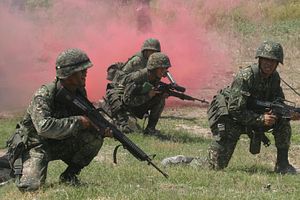Last week, the United States and the Philippines kicked off the latest iteration of a new exercise between them. The holding of the drills and the focus on certain aspects of them underscored both the ongoing security collaboration between the two treaty allies as well as the broader significance of their engagements for the alliance and the wider region.
As I have noted before in these pages and elsewhere, the United States and the Philippines, both treaty allies, have a defense relationship that consists of a range of interactions on the security side. In spite of the challenges the alliance has seen under Philippine President Rodrigo Duterte – from the rebranding of certain drills to a rethink of the alliance relationship more generally – much of that security collaboration continues and has in fact increased in some aspects.
Among one of the newer manifestations of U.S.-Philippine defense collaboration in this respect is Exercise KAMANDAG. KAMANDAG, an acronym for the Tagalog phrase “Kaagapay Ng Mga Mandirigma Ng Dagat,” which translates in English roughly to “Alongside the Warriors of the Sea,” was originally discussed as a replacement exercise following the initial cancelation of the U.S.-Philippine Amphibious Landing Exercise (PHILBEX) during Philippine President Rodrigo Duterte’s initial entry into office.
KAMANDAG was first held in 2017, with the United States and the Philippines highlighting its focus as being on enhancing capabilities across a range of areas including humanitarian assistance and disaster relief, internal security operations, and counterterrorism. Iterations of KAMANDAG, like PHILBEX, have consisted of various aspects including a command post exercise, field training exercises, amphibious operations, combined arms training, civil-military operations, and humanitarian and civic assistance projects.
Last week, the defense aspect of the US-Philippine relationship was in the headlines again with the holding of the latest iteration of KAMANDAG. The exercise officially began on October 9 at Subic Bay International Airport at Subic Bay Freeport Zone in the Philippines.
Per comments given by Philippine Marine Corps (PMC) spokesperson Felix Serapio, this year’s iteration of KAMANDAG runs from October 9 to October 18, even though preparatory aspects of the exercise had already been underway previously as well. As per earlier iterations, it includes a series of interactions, including the amphibious exercise taking place on October 12 at the Marine Barracks Gregorio Lim, Ternate Cavite and final exercise involving the firing of artillery and tank weapons at the Col. Ernesto Rabina Air Base, in Capas, Tarlac on October 17, before it ends with a closing ceremony at the Marine Base Rudiardo Brown, Fort Bonifacio, Taguig City on October 18.
As with previous iterations, there has been a focus on aspects of the exercise from a range of perspectives. For one, there has been an emphasis on the Philippines’ capabilities amid its ongoing military modernization efforts, including the involvement of newly-acquired amphibious assault vehicles in the exercise. For another, there has been a focus on ongoing efforts to involve other countries beyond the United States and the Philippines, with Japan being involved this year as well. While these aspects are by no means new, they are nonetheless among those to consider in order to assess the extent of continuity and change with U.S-Philippine defense engagements such as KAMANDAG as well as their significance for the two allies and the wider region.

































